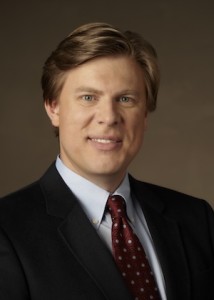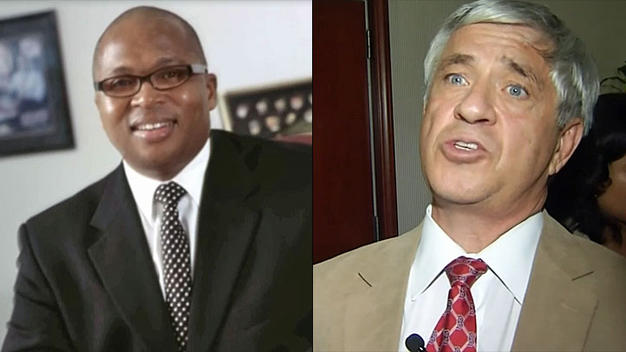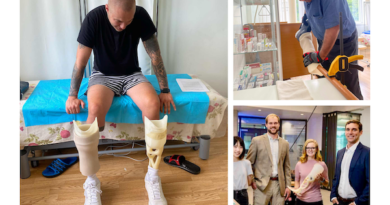Daily Business Report-Oct. 16, 2013
During the procedure, life-threatening clots and scar tissue are removed from the arteries in the lungs. In order to do that, doctors have to put patients into a form of suspended animation, said surgeon Michael Madani.
UC San Diego Surgeons Reach Lung Surgery Milestone
A woman from Missouri has become the 3,000th patient to get a special type of lifesaving lung surgery at UC San Diego. The operation removes clots that rob patients of their ability to breathe, KPBS reports. The surgery was developed at UC San Diego in the early 1970s. UCSD’s Sulpizio Cardiovascular Center performs more of the procedures than any other facility in the world.
The surgery is called a pulmonary thromboendartectomy. During the procedure, life-threatening clots and scar tissue are removed from the arteries in the lungs. Surgeon Michael Madani, co-director of the Sulpizio Cardiovascular Center, said in order to do that, doctors have to put patients into a form of suspended animation.
“Essentially, everything in the patient is flat lined, including brain waves, heart, and there is no blood flow anywhere in the body,” Madani said.
The surgery takes about 10 hours to complete. Madani said it’s the best way to help patients who suffer from what’s called pulmonary hypertension. About 25,000 Americans have this condition.
“This operation could be potentially curative,” Madani said. “And patients can go back, enjoy almost a normal lifestyle to the point that they were before they got the blood clots.”
Susan Geertsen, 55, is the 3,000th patient to go through the surgery at UC San Diego. She had it last week, and she’s already able to cut way down on bottled oxygen.
When she came to the hospital, Geertsen could hardly breathe.
And now? “I think I’ve got a few years ahead of me, quite a few,” Geertsen said, smiling.
September’s Home Sales in County Drop
From August But Rise Above Last Year
San Diego County home sales in September dropped from August but rose modestly above a year earlier, San Diego-based DataQuick reported today.
Home sales dropped from 4,099 in August to 3,383 in September. Home sales in September of last year totaled 3,214.
The median sales price in the county in September was $422,000 compared to $415,000 in August and $350,000 in September of last year.
Southern California:
Southern California home sales in September fell more than usual from August but rose above a year earlier as sales gains for mid- to high-priced properties compensated for declines in sub-$300,000 activity. The median sale price remained 21 percent higher than a year earlier, but after holding steady for three months the median dipped month-to-month in September for the first time since February, a real estate information service reported.
A total of 19,112 new and resale houses and condos sold in Los Angeles, Riverside, San Diego, Ventura, San Bernardino and Orange counties last month. That was down 17.1 percent from 23,057 sales in August, and up 7.0 percent from 17,859 sales in September 2012, according to DataQuick.
On average, Southland sales have declined 9.3 percent between August and September since 1988, when DataQuick’s statistics begin.
The median price paid for all new and resale houses and condos sold in the six-county region last month was $382,000, down 0.8 percent from $385,000 in August and up 21.3 percent from $315,000 in September 2012. The $385,000 median in June, July and August was the highest in more than five years.
“We’ve seen a fairly normal downshifting in the housing market this fall,” said DataQuick President Joh Walsh. “Couple that with the rise in inventory, higher mortgage rates and the ongoing, gradual drop in purchases by investors and cash buyers and it’s no wonder prices have leveled off in recent months. What’s not clear is how well the market can weather the job losses related to the federal government shutdown and the blow to consumer confidence caused by fears of a default in the national debt. Those impacts would start to show up in data released over the next couple of months.”
San Diego Attorney Spearheads Milestone
Class Action Lawsuit with Bank of America

A San Diego attorney has settled a milestone “robo-calling” class action lawsuit against Bank of America for more than $32 million. Attorney Mark Ankcorn, of counsel to San Diego-based CaseyGerry, filed and litigated the case — which stemmed from charges the banking giant harassed consumers who fell behind on mortgage and credit card payments — for more than two years. According to Ankcorn, this is the largest cash payout ever under the
Telephone Consumer Protection Act (TCPA), which was designed to protect consumers from unwanted phone calls. Settlement papers were filed in federal court in San Jose and the proceeds will go to nearly eight million consumers in the class.
As the nation’s largest mortgage servicer, Bank of America was violating federal law by making hundreds of millions of illegal calls each year, Ankcorn said. “Consumers who fell behind on mortgage payments were harassed by Bank of America relentlessly,” he said. “When someone was late on payments, Bank of America would transfer all known telephone numbers for the account into a computerized calling system that would make as many as seven calls per day, per number. This harassment was intense and ongoing – and violated federal law by running up cell phone bills for millions of consumers across the country.”
According to the Federal Trade Commission, the number of robo-calls is soaring – thanks to new, inexpensive technology that enables companies to send out thousands of calls per minute. Making auto-dialed calls to cell phones without the customer’s consent is illegal under the TCPA.
As part of the settlement, Bank of America also agreed to implement sweeping changes to its business practices and obtain separate consent before making any robo-dialed call to a cell phone.
Fight Over Barrio Logan Plan Not Over Yet
A divided San Diego City Council yesterday reaffirmed its approval of a long-debated community plan for Barrio Logan, even as two of the candidates running for mayor refused to bend on their opposing positions, the U-T San Diego reported. The plan, as it did during a lengthy public hearing last month, drew strong statements from longtime residents and environmental advocates who favor the document and maritime businesses who are seeking to overturn it in a referendum. In the end, mayoral candidate City Councilman David Alvarez, who represents the community, remained firm in his support, while City Councilman Kevin Faulconer, a mayoral rival, voted against the plan, fearing that it will cost thousands of maritime-related jobs.
Former Mayor Filner Pleads Guilty to Three Crimes
Sentencing set for Dec. 9
(AP) — Former San Diego Mayor Bob Filner, driven from office by sexual harassment allegations, pleaded guilty on Tuesday to a felony and two misdemeanors for unwanted physical contact with three women at public events. Filner entered the plea under an agreement that calls for three months of home confinement and three years of probation, the California attorney general’s office said. Filner was charged with felony false imprisonment and two counts of misdemeanor battery.
The felony involved a woman restrained against her will at a fundraiser. The misdemeanors involved a woman who was kissed without permission and a woman whose buttocks were grabbed. The victims were identified only as Jane Does. The plea deal also requires mental health treatment.
The maximum possible sentence for the felony is three years in prison and one year for each misdemeanor. Sentencing was set for Dec. 9.
Filner, 71, resigned in late August, succumbing to intense pressure after at least 17 women brought lurid sexual harassment allegations against the former 10-term congressman. He had been on the job less than nine months into a four-year term and was San Diego’s first Democratic mayor in 20 years.
Alcazar Garden Parking Lot in Balboa Park to Get Facelift
The San Diego City Council on Tuesday voted unanimously to spend $150,000 on improvements to the Alcazar Garden parking lot in Balboa Park, which will result in the addition of more handicapped spaces, City News Service reports. The condition of the lot has become an issue since parking spaces were removed in the nearby Plaza de Panama earlier this year, forcing people with disabilities to use the Alcazar spots. According to staff, the grade in the Alcazar Garden parking lot is too steep and the pavement is being uprooted by nearby trees, creating difficult conditions for the elderly and disabled. The project will result in the number of handicapped spaces going from five to 14, at the cost of 15 standard slots, according to the staff report. Preliminary engineering work is already underway, with the project due to be completed next spring.
Correction:
An item in Tuesday’s Daily Business Report incorrectly reported the date of a sign unveiling ceremony at Quidel Corp.’s Ohio Technology Center in Athens, Ohio. The ceremony will be at 12:30 p.m. today, followed by a tour of the facility’s $3.5 million molecular diagnostics suite.
Technology

The Right Connections
Students attending the Oct. 24 Engineering and Sciences Career Fair at San Diego State University can take advantage of new software called Proximity to connect them instantly with potential recruiters. Developed by SDSU engineering professor Mahasweta Sarkar and colleagues, the software and corresponding mobile application — or app — matches a student’s resume to an ideal profile created by the recruiter. Proximity was designed to facilitate personal networking at events including professional conferences, trade shows and campus career fairs.
A grant from the National Science Foundation’s competitive I-Corps program financed extensive interviews and testing to determine the commercial viability of Proximity. The I-Corps team included Sarkar, the principal investigator, as well as SDSU post-doctoral researcher Christopher Paolini and local entrepreneur Les Briney.
Sarkar and her team worked with SDSU Career Services to create the downloadable app called Proximity, available for participants at the Oct. 24 Engineering and Sciences Career Fair. The student logs in with a name and Red ID, and the app displays a full list of companies present at the fair along with a short description of each one. At the touch of the “Match Me” tab on the app, the software eliminates some companies to display a “short list” of recruiters looking for expertise that matches the particular student’s skill sets. Additionally, the app displays the location of the recruiters’ booths on a map of the fair.
HTC Offers Larger Phone, With Fingerprint Sensor
NEW YORK (AP) — At your neighborhood coffee shop, you can order your beverage in small, medium or large. Now, you can do that with phones, too. HTC Corp. is introducing a larger version of its popular HTC One phone, becoming the latest phone maker to offer its flagship device in three sizes — and, of course, three prices. The price hasn’t been announced, but it likely will be comparable to the $300 for the Note 3 and Motorola’s Droid Maxx

The new HTC One Max has one feature unavailable on the smaller models: a fingerprint identification sensor similar to that on Apple’s new iPhone 5S. It’s an optional way to unlock a phone without using a four-digit passcode. Unlike Apple’s version, however, the Max can be programmed to automatically open one of three favorite apps, depending on which finger is used.
HTC spokesman Tom Harlin said the company designed the Max with a fingerprint sensor to make the larger device easier to operate with one hand. Engineers also moved the power button to the side. On smaller models, it’s on top of the phone, when held vertically.
The Max has a screen that measures 5.9 inches diagonally. That compares with the 4.7 inches on the standard version and the 4.3 inches on the HTC One Mini. HTC is designing its software to take advantage of the larger screen. With many Android phones, images and text simply get larger on bigger phones. With the Max, the layout of selected apps is reformatted to fit more content.
The Max also has more battery capacity than the smaller models, but otherwise shares their design and hardware features. Like the other Ones, the Max has a camera that can capture better low-light shots than the typical smartphone camera, but images are of lower resolution, at 4 megapixels. The Max weighs 7.7 ounces, which is more than the 5.9 ounces for Samsung’s 5.7-inch Galaxy Note 3.
New iPads Likely to be Announced Next Week
CUPERTINO, Calif. (AP) — Apple is holding an event in San Francisco next Tuesday to announce new products — likely updated iPads. The company announced its most recent iPads around this time last year. The announcement included a smaller version, called the Mini, for the first time. New iPads would get Apple’s latest operating system for mobile devices, iOS 7. The invitation sent Tuesday includes a graphic that mimics the color scheme in iOS 7.
It’s also possible Apple will use the event to release its new Mac operating system, Mavericks. Apple unveiled the system in June. The system will support tagging to help you find files more easily. It also promises better battery life and a way to keep track of passwords across multiple devices more easily. Apple may also announce new Mac computers at the event.




